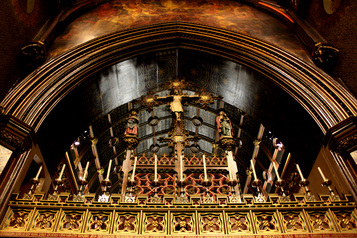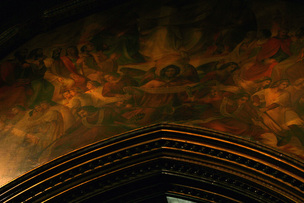The St Giles' Tour |
|
|
The Rood Screen
The Rood Screen is the most prominent feature of the church. Pugin believed that, in an English Parish Church, the screen was indispensable. Its function was two-fold. In the first place it was there to support the Rood, or great Crucifix, with its attendant figures of Our Lady and St. John, as the principle focus of devotion for the people in the nave. The screen also acted as a kind of window, through which those in the nave could view the splendours of the chancel during Mass - a foretaste of heaven, and the life of the world to come. As the nave of the church was the preserve of the Church Militant, so the separate chancel was symbolic of the Church Triumphant. It is impossible to go from one to the other without going under the cross - another symbolic act. The Cheadle screen was created locally out of oak from the Alton estate. The capitals of the main shafts, and the tracery at the head of each division, have very finely carved flowers and leaves. There are angels' heads over the doorway, and there is a rich cornice of vine-scroll above the coving. Over the cornice there runs the painted Latin text which reads in translation: For Jesus became obedient to death, even death on the cross, therefore God has exalted him and given him the Name which is above all others (Philippians 2. 8-9). The Doom Above the Chancel arch is the Doom, a representation of the Last Judgement which, in Christian theology, will take place at the Second Coming of Christ which is shown at the top of the painting. The Doom was a common feature of English parish Churches, but they were largely destroyed or whitewashed-over at the time of the Reformation. The one for St. Giles was painted on canvas in Rome, and shipped over. The Doom as an important local reference. In the bottom left hand corner of the painting, amongst the Blessed, is a likeness of Gwendaline, the younger daughter of the Lord and Lady of Shrewsbury. She is dressed in white, and wears a garland of white flowers in her hair. Gwendaline was married to the Italian Prince Marc Antonio Borghese and they lived in Rome. Tragically, she died from scarlet fever in October 1840, just a few weeks before her 23rd birthday, and was buried in the magnificent Borghese chapel in the basilica of St. Mary Major. Return to the St Giles' Tour
|
Return to the St Giles' Tour
|
|
St Giles is part of the Archdiocese of Birmingham - Charity No. 234216
|
Website by Gabriel Media Limited
|



